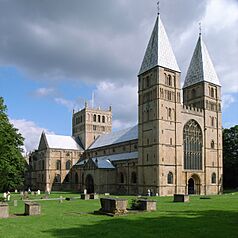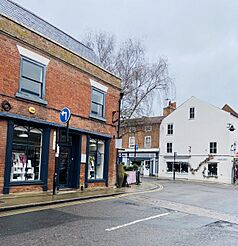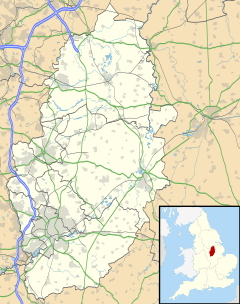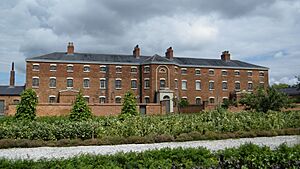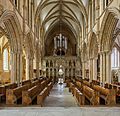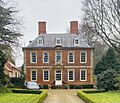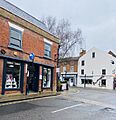Southwell, Nottinghamshire facts for kids
Quick facts for kids Southwell |
|
|---|---|
| Town and Civil parish | |
|
From the top: Southwell Minster, The Archbishop's Palace, The Workhouse and Market Place/Kings Street
|
|
Civil parish map |
|
| Area | 7.70 sq mi (19.9 km2) |
| Population | 7,491 (2021) |
| • Density | 973/sq mi (376/km2) |
| OS grid reference | SK 69996 53962 |
| • London | 110 mi (180 km) SSE |
| District |
|
| Shire county | |
| Region | |
| Country | England |
| Sovereign state | United Kingdom |
| Post town | SOUTHWELL |
| Postcode district | NG25 |
| Dialling code | 01636 |
| Police | Nottinghamshire |
| Fire | Nottinghamshire |
| Ambulance | East Midlands |
| EU Parliament | East Midlands |
| UK Parliament |
|
Southwell (pronounced SOWTH-wəl or SUDH-əl by locals) is a historic town in Nottinghamshire, England. It is famous for its large church, Southwell Minster, which is a cathedral. A cathedral is the main church for a diocese, which is an area managed by a bishop. Southwell is also a market town, meaning it has a long history of holding markets where people buy and sell goods. In 2021, about 7,491 people lived there.
Contents
What's in a Name? The Origin of Southwell
The name "Southwell" is a bit of a mystery. No one is completely sure where it came from. Some people think it refers to a specific "well" or spring in the town. There are a few places that claim to be the original well, like one near the Minster called Lady Well.
There's also a town called Norwell about 8 miles (13 km) away. This might suggest there were once "south" and "north" wells. However, no wells are known in Norwell. Locals in most of Nottinghamshire say "SUH-thull" for Southwell. But people who live in Southwell usually say it as it's spelled, "SOWTH-wəl".
Southwell's Rich History
Southwell has a long and interesting past, going back thousands of years.
Ancient Times: Romans and Anglo-Saxons
Archaeologists found the remains of a fancy Roman villa under the Minster in 1959. A piece of a wall painting from this villa is now on display in the Minster. This shows that important Romans lived here.
An old writer named Bede wrote about a large baptism that happened in the River Trent in 627 AD. A Christian leader named Paulinus performed it. He might have started the first church in Southwell.
Later, the remains of Eadburh, an abbess (leader of a group of nuns) from Repton, were buried in Southwell's old Saxon church. She was a saint and people visited her burial place in the Middle Ages.
The first written record of Southwell dates back to 956 AD. This was when King Eadwy of England gave land in Southwell to the Archbishop of York. By 1051, there was likely an archbishop's home and church here. The Domesday Book from 1086 also mentions a large estate belonging to the archbishop in Southwell.
Medieval Customs and Royal Visits
After 1109, a tradition called the "Gate to Southwell" began. The Archbishop of York asked churches in Nottinghamshire to help pay for a new main church (the Minster). Every year at Whitsun, people would bring these payments to the Minster in a parade. The word "gate" here means "street," like in many old English street names. This tradition continued for centuries.
Many important people visited Southwell. In 1194, King Richard I (Richard the Lionheart) was in Southwell. King John also visited between 1207 and 1213, often to hunt in nearby Sherwood Forest.
The Saracen's Head and the English Civil War
The famous Saracen's Head building was built in 1463. It was originally called the King's Head. In 1530, Cardinal Thomas Wolsey stayed at the archbishop's palace in Southwell for several months. He was a very powerful church leader.
During the English Civil War in the 1640s, King Charles I spent his last night as a free man in May 1646 at the Saracen's Head. He then surrendered to the Scottish Army nearby. The town, the Minster, and the Archbishop's Palace were damaged by Oliver Cromwell's soldiers. They used the palace to stable their horses and took valuable items. By the end of the war, the Archbishop's Palace was mostly in ruins.
The Bramley Apple and Later History
The famous Bramley cooking apple first grew in Southwell. Mary Ann Brailsford planted the seed in 1809. A local plant seller, Henry Merryweather, saw how special it was and started growing it from cuttings. The Bramley apple is now known worldwide for its tart taste and how well it cooks into a smooth sauce. Southwell even has a football team nicknamed "The Bramleys" and a library called the Bramley Centre. In 2009, a stained-glass window was put in Southwell Minster to celebrate the apple's 200th birthday.
In 1803, the famous poet Lord Byron lived in Burgage Manor with his mother. They rented the house because their family home needed repairs they couldn't afford.
The Diocese of Southwell was created in 1884, making Southwell Minster its main church. This diocese covers the area of Nottinghamshire.
Southwell's Location and Surroundings
Southwell is located on the River Greet. It is about 9 miles (14 km) west of Newark on Trent and 15 miles (24 km) northeast of Nottingham.
Parts of the Town
Southwell has grown over time, with smaller communities joining the main town.
- The Prebendage was the old heart of Southwell, around the Minster and its church buildings.
- Burgage was north of the cathedral, known for its traditional properties.
- Hightown was the main shopping street, to the northwest.
- East Thorpe and West Thorpe were small villages on either side of these areas.
Nearby Areas
Outside the main town, but still part of the local area, are:
- Normanton: A small village on the east side of the River Greet.
- Maythorne: A small village with an old silk mill, north of the town.
- Brackenhurst: Home to an agricultural campus of Nottingham Trent University.
- Brinkley: A small village to the southeast.
Local Economy
Southwell is known for being a prosperous town in North Nottinghamshire. While other nearby towns have seen their economies change with farming and coal, Southwell has remained a popular place for wealthier people from Nottingham to live. It was even named one of the "Best Places to Live" in the Midlands in 2017 by the Sunday Times.
Culture and Fun in Southwell
Southwell offers many interesting places to visit and events to enjoy.
Important Buildings and Places
The most important building in Southwell is the Southwell Minster. It's a beautiful old church and the cathedral for the area. Behind the Minster are the ruins of a palace where the Archbishop of York used to live. You can still see parts of the palace, including the Great Hall.
The town also has many other historic buildings. One unique place is The Workhouse, built in 1824. It was a model for many other workhouses in England. Now owned by the National Trust, it shows what life was like for poor people in the 19th century.
Local News and Music
The local newspaper for the community is The Bramley. It's delivered for free to homes in and around Southwell.
Southwell also has two annual music festivals. The Southwell Music Festival happens every August, with concerts in the Minster and other places. The Gate to Southwell Festival, which focuses on folk and acoustic music, takes place each year in early June.
Learning in Southwell
Southwell has good schools for different age groups.
The town has two infant schools for young children. For older students, the main secondary school is Southwell Minster School. This school is special because it also teaches the choristers (singers) of the Minster and talented young musicians. It's known for its excellent exam results.
Nottingham Trent University also has its Brackenhurst campus just outside Southwell. Here, students can study subjects related to farming, animals, and the environment.
Getting Around Southwell
Southwell is connected to other towns by roads and bus routes.
Road Connections
The town is linked to Newark and Nottingham by a local road. Larger main roads like the A1 and A46 are about 7 miles (11 km) away in Newark.
Bus Services
Buses in Southwell are mainly run by Nottingham City Transport and Stagecoach East Midlands. You can take buses to Nottingham, Mansfield, and Newark. There are also some less frequent services to nearby villages.
| Bus operator | Route number | Destination(s) | Notes |
|---|---|---|---|
| Nottingham City Transport | 26:Lilac Line | Nottingham – Carlton – Burton Joyce – Lowdham – Southwell | |
| Stagecoach East Midlands | 28 | Mansfield – Rainworth – Southwell – Newark | |
| 29 | Mansfield – Newark | ||
| Travelwright | 3 | Lowdham – Southwell – Newark | |
| 227 | Newark – Southwell – Bilsthorpe – Edwinstowe | Wednesday & Friday only. | |
| Sherwood Countryman Buses | CM2 | Maplebeck – Eakring – Kirklington – Southwell |
Train Travel
The closest train station to Southwell is at Fiskerton, about 2 miles (3 km) away. It has a small car park for people from Southwell who travel by train. Rolleston station is also nearby. Both stations are on the line between Nottingham and Lincoln. You can catch trains to places like Crewe, Newark Castle, Leicester, Lincoln, and Nottingham.
Southwell used to have its own train station, but it closed in 1959 for passengers. The old railway line is now a path called the Southwell Trail, which is great for walking and cycling.
Sports and Activities
Southwell has several sports clubs for different interests.
- Southwell Rugby Club: Known as the Redmen, this club started in 1922. They have won several championships and cups.
- Southwell City Football Club: This is a large club with over 400 local players in 35 teams, from young children to adults.
- Southwell Cricket Club: They play at Brackenhurst Cricket Ground.
Southwell Racecourse is just outside the town near Fiskerton. It's a place where horse races are held on an all-weather track.
Southwell also has a leisure centre run by a local group. It provides support for sports and fitness activities in the community.
Famous People from Southwell
Many interesting people have connections to Southwell:
- St Edburga of Repton (died around 700 AD): A saint whose remains were buried in Southwell.
- Ælfric Puttoc (died 1051): An Archbishop of York who died here.
- Geoffrey Plantagenet (ordained 1181): The natural son of King Henry II, who became Archbishop of York.
- Mary Ann Brailsford (baptised 1791): The person who first grew the famous Bramley cooking apple tree from a seed.
- Rev. John Thomas Becher (1770–1848): A friend of Lord Byron and a social reformer.
- Lord Byron (1788–1824): A famous poet who lived in Southwell with his mother during his school holidays.
- Ted Hufton (1892–1967): An international footballer born here.
- Sir Joseph Lockwood (1904–1991): His company helped to fund The Beatles.
- Alvin Stardust (1942-2014): A singer and actor who attended Southwell Minster Collegiate School.
- Mathew Horne (born 1978): An actor known for his role in the TV show Gavin & Stacey, who studied at Southwell Minster School.
- Robert Edward Jenrick (born 1982): A Member of Parliament for Newark.
- Scott Loach (born 1988): A professional footballer who attended Southwell Minster School.
Sister Towns
Southwell is twinned with three towns in other countries:
- Sées in France
- Sarzana in Italy
- Český Brod in the Czech Republic
Images for kids
-
Lord Byron's house – Burgage Manor
See also
 In Spanish: Southwell para niños
In Spanish: Southwell para niños


